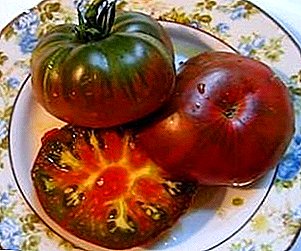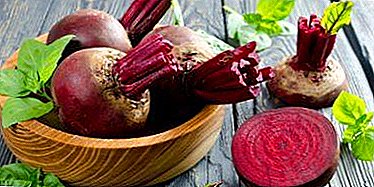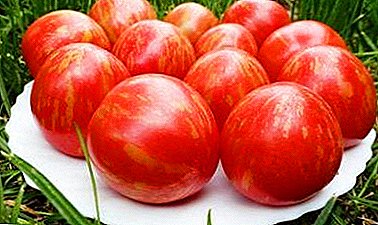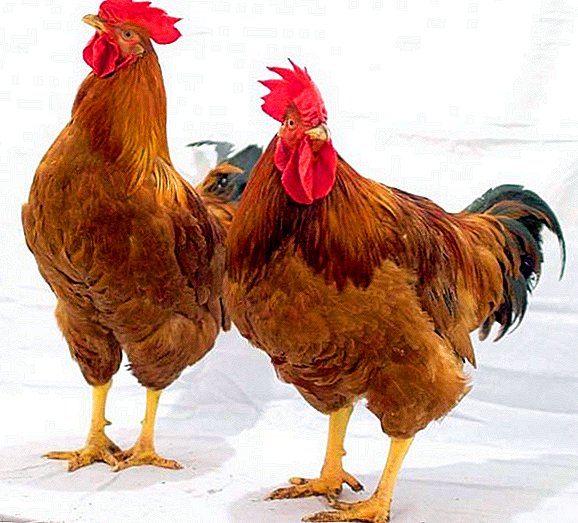 Today we will talk about what constitutes a breed of redbrow chickens, learn the rules of growing, keeping and breeding. Recently, many farmers have abandoned broilers due to poor immunity and low meat value, looking for a good substitute. From this article, you will learn what the redbro breed is valued for and why it is better than others.
Today we will talk about what constitutes a breed of redbrow chickens, learn the rules of growing, keeping and breeding. Recently, many farmers have abandoned broilers due to poor immunity and low meat value, looking for a good substitute. From this article, you will learn what the redbro breed is valued for and why it is better than others.
Description of redbro chickens
Redbro chickens have characteristics and qualities that can be used to make a clear description of the breed.
Redbro refers to the breeds of meat and egg direction. The bird is of English origin, but at the moment it is being mass bred in the USA and France. About all the intricacies of the breed will be discussed below.
History of origin
 Work on breeding redbro breed began in the first half of the twentieth century.
Work on breeding redbro breed began in the first half of the twentieth century.
At the beginning of the section, we mentioned that England is the birthplace of this breed, where the bird was hatched to produce tasty and nutritious meat.
An interesting feature is that the beautiful thick plumage and slender type of bird is not at all the merit of the breeders, but a successful coincidence of genes. The breed was taken out for households, so all difficult moments were taken into account in terms of temperature, feed quantity and lighting. As a result, we received an excellent unpretentious breed of chickens, which gives an average number of eggs and gaining good weight until the moment of slaughter.
External characteristics
If you do not say that before you are pedigree chickens of meat and egg direction, then you will take them for ordinary domestic chickens, which have a well-groomed appearance and slightly increased head size.
Redbro have clearly defined head features: short beak, regular straight red comb and bright ear lobes.
Looking carefully, you can see the massive legs that are hidden by the plumage. In the process of breeding redbro got legs, similar to the fighting breeds of chickens.
The most popular color variations are red and brown-red.
Temperament chickens
 As a result of breeding, chickens have acquired negative character traits - temper and aggressiveness, but this does not mean that they will start throwing themselves at you. Only the roosters who protect their territory and chickens are afraid.
As a result of breeding, chickens have acquired negative character traits - temper and aggressiveness, but this does not mean that they will start throwing themselves at you. Only the roosters who protect their territory and chickens are afraid.
In case you pose a danger to them, the roosters may even attack. Chickens are not overly aggressive, so they will definitely not rush at you at the time of collecting eggs or feeding.
Important! Chickens can become more aggressive if the enclosure is very small for them or in the absence of the required number of feeders.
Productivity
As for productivity, the birds of this breed have excellent performance: average egg production is 260 eggs per year, the maximum weight of the chicken carcass is 2.6-2.7 kg; rooster - 4-4,5 kg. Rush redbro begin at the age of 5-6 months. It should be noted that the meat after slaughter has excellent taste and belongs to the highest category in terms of gastronomic indicators.
Advantages and disadvantages of the breed
 Knowing the appearance and productivity is not enough, since when breeding a bird, one must always take into account the positive and negative sides of the breed in order to make the exact decision.
Knowing the appearance and productivity is not enough, since when breeding a bird, one must always take into account the positive and negative sides of the breed in order to make the exact decision.
Let's start with the pros.
- The bird has a beautiful appearance, which positively affects its aesthetic value.
- Redbro give a sufficient amount of delicious dietary meat, which can be used for their own needs, and for further implementation.
- The breed has strong immunity, which means that even in tight aviaries the bird will not begin to ache from the slightest draft. Saving on vaccinations and special additives, you reduce the cost of the final product.
- The combination of good egg production and large weight make it possible to use chickens first to get eggs, and then for sale for meat.
Therefore, we can conclude: if you are not going to use chickens solely for breeding chickens, then feel free to buy a young bird and enjoy tasty eggs and dietary meat.
How not to make a mistake when buying
 Since redbird chickens do not differ in their special "uniqueness", it is almost impossible to distinguish them from ordinary chickens.
Since redbird chickens do not differ in their special "uniqueness", it is almost impossible to distinguish them from ordinary chickens.
In fact, many sellers know about it and successfully use this similarity. What to do in this case?
As you may have guessed, chickens need to be bought at an age when the species differences will be noticeable. That is, if you want to buy a pedigree bird, you will have to look for young chickens and cockerels, which, naturally, will cost more than chickens.
You can distinguish a redbro from ordinary chickens after the first molt, then the species differences will be most noticeable. The main difference is quick weight gain. Unlike ordinary redbrow birds, already at one month of age have a mass of more than 1 kg.
If you want to buy chickens, then get the young either from good friends, or on chicken farms, which are not just breeding and selling chickens, but specialize in thoroughbred poultry.
Rules for feeding and caring for the young
To get at the slaughter of really good meat, you need to worry about the diet of chickens at an early stage.
After purchase, the chicks should be immediately placed in the heat. The average temperature in the room where young animals are kept should not fall below 30 ° C. If the room is colder, the chickens will become overcooled and die. To young growth does not grow "greenhouse", with each subsequent week, the temperature is reduced by two degrees.
Many owners believe that the young in the first weeks after the purchase will be more comfortable in a cramped box or a small chicken coop, however, like any other bird, redbro chickens require walks. In order to prevent mass retardation, walks should be short and only in warm closed enclosures.
Did you know? Rooster seed is stored in the chicken for about a month. During this time, a hen can produce several dozen fertilized eggs.
 Redbro even have good immunity, but you should not forget about the standard rules of hygiene, so keep the litter dry and regularly clean the chicken coop from excrement and food debris. If you keep clean, you will minimize the loss of young stock.
Redbro even have good immunity, but you should not forget about the standard rules of hygiene, so keep the litter dry and regularly clean the chicken coop from excrement and food debris. If you keep clean, you will minimize the loss of young stock.
As for feeding, then everything is ambiguous. If you keep a few dozen chickens that you do not plan to slaughter in 5-6 months, you can use the “standard” diet of ordinary chickens. In this case, the weight gain will not be so fast, but the maintenance of pedigree birds will not bring additional costs.
In the event that you purchased several hundred heads and you want to put them for meat in six months, then feed the chickens using the same system as the broilers. Chickens that are from 11 to 24 days old are fed with small granules (2-3.5 mm) or in bulk meal. If you bought a young growth that was not yet 10 days old, use only microgranules or sifted cereals.
It is worth remembering that any food in the first two weeks of life should be readily soluble (millet, oatmeal, boiled eggs). From the fifth day of life, finely chopped greens and protein foods are introduced into the diet.

When calculating the diet for young stock, refer to the broiler chicken rearing scheme, which is best suited for mass breeding of poultry. Do not forget that, consuming dry food, the bird needs a lot of water, which should be between 16-22 ˚ С, fresh and clean.
Important! The young need a large amount of minerals and vitamins to keep the bones after muscle growth and fat gain, otherwise the chickens will simply begin to break and rot legs.
Thus, the content of redbrow chicks is possible both in small farms and on huge poultry farms. The only difference is in the diet and time of slaughter.
Features of keeping redbro chickens
Redbro chickens do not require special conditions of detention, which is a huge plus. Of course, if possible it is worth making free-standing type of contentin which the poultry meat will be much tastier, the hens themselves will find the herbs and minerals they need. In the summer and spring, this type of housing will significantly reduce the cost of feeding, but with a large population of birds, this type of content is impossible.
With closed content type Redbro also gains weight well and rushes. The only difference is that the bird needs to add a large amount of minerals to the food, the feed must be saturated with calcium and protein so that the eggs have a productive value.
Do not forget that the molting period is the most dangerous. No matter how healthy the bird is, at this time it can be afflicted with disease. This may occur due to poor feeding or poor sanitation. It is also worth remembering that chickens should be kept at a temperature of 7 to 25 degrees. Severe overheating or hypothermia will lead to weight loss and disease.
Did you know? Chickens love to lay eggs in the "company", sing loudly at the time of laying and after it, telling others about their joy.
Feeding adult chickens
When breeding redbrow chickens, “broiler” feeding is preferred, when the lion’s share of the diet is mixed feed. In addition to dry food, various minerals, vitamins and herbs are added to get a quick weight gain. Growing chickens in a small chicken coop, you can feed them whole wheat, barley, various masses and "goodies."
It is important to remember that the bird is quite voracious and consumes as many calories per day as an adult (about 3.5 thousand kcal), so if you want to “save”, the chickens will start fighting among themselves for food and the mass will slow down. . Try to feed the bird at least three times a day in the summer if it is kept without walking.
 It is worth remembering that, as in the case of feeding chickens, an adult bird needs plenty of clean water. The correct ratio of feed and water is 1: 1.7. That is, pouring 1 kg of feed, provide the chicken with 1.7 liters of water.
It is worth remembering that, as in the case of feeding chickens, an adult bird needs plenty of clean water. The correct ratio of feed and water is 1: 1.7. That is, pouring 1 kg of feed, provide the chicken with 1.7 liters of water.
Thus, the maintenance and feeding of redbrow chickens can be compared with both broilers and ordinary domestic chickens. It is worth remembering that the high cost of animal feed will give an impressive result, so do not save on nutrition if you want to get tasty and healthy meat.
Diseases and treatment of redbreed chickens
Unpleasant section of the article, in which we will talk about the possible diseases of chickens and their treatment.
It should immediately be said that, unlike broilers, redbrow chickens do not need to pour antibiotics into food to prevent diseases.
Since redbro are breeding breeding breed, they have resistance to many diseases. And in the event that they get sick, the recovery period is several times shorter than that of ordinary domestic chickens.
Typhus An infectious disease that causes diarrhea and vomiting in a sick bird. Typhus is transmitted by airborne droplets. In sick chickens, there is a lack of appetite, fever and general weakness. The disease is treated only with antibiotics.
Coccidiosis Parasitic disease that is transmitted through contact with a sick bird. Symptoms are similar to typhoid, but in this case depression is added to the ailments. It is treated with the following drugs: Furagin, Zolen and Coccidin. 
Salmonellosis. The causative agent is Salmonella (bacterium). The most important symptom is a noticeable swelling around the eyes. Most poultry is vaccinated against this disease, however if your chickens were not vaccinated and got sick, then they need to be treated with furazolidone. Add the medicine to drinking water for ten days and the bird will recover.
The information presented makes it clear that redbro chickens have excellent characteristics: they are durable and productive, can be grown in different climates, on the range or in closed cages. The cost of buying and feeding the birds will be repaid with interest if you adhere to the rules of rearing and use the experience gained in practice.












